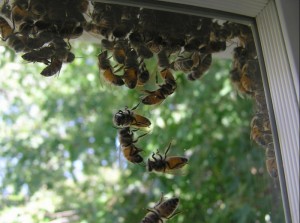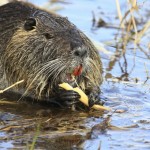The Top Ten Invasive Species in Texas

Photo courtesy of Flickr user riko.jennrich/Creative Commons
Nutria are one of the more notorious invasive species in Texas
Burros, armadillos, bluebonnets, and pecan trees are just a few examples of the diverse flora and fauna that one might come across in Texas. While some of these species have become a source of state pride, others are much less welcome.
Over the past few decades, a coterie of invasive species has trespassed into the Lone Star State. The federal government defines an “invasive species” as “a species that is non-native or alien to the ecosystem” and “causes or is likely to cause economic or environmental harm or harm to human health.” Zebra mussels, Africanized bees, and feral hogs are just a few of the invasive species that have made their presence known in Texas.
Combined, invasive species have caused an immense amount of agricultural, ecological, and economic damage. Local scientists are worried that they’ll continue to wreak havoc unless state regulators and citizens alike start implementing stronger measures to stop them from spreading.
The photo gallery below shows the top ten invasive species in Texas, along with brief summaries of the damage they’re causing to the state.

Courtesy of NOAA Great Lakes Environmental Research Laboratory via Flickr Creative Commons
Zebra mussels
1. Zebra Mussels
Zebra mussels have become the poster child for invasive species in Texas. Originally from the Black and Caspian Seas, these quick-breeding mollusks have recently invaded several Texas lakes, most profoundly Lake Texaoma, and they threaten to take over the Trinity River Basin next. Zebra mussels have caused alarming declines in fish, birds, and native mussels by over-absorbing phytoplankton, an essential food source for many aquatic species. Its high rate of filtration also leads to increased sunlight penetration, raising water temperatures and the depth at which that light penetrates the water. Zebra mussels also negatively impact the aquatic industry. They can adhere to just about any surface, including pipes, boats, boat trailers, buoys and dinghys, and once they do, they’re permanently secured. In several instances, they’ve been reported to have sunk entire buoys and destroyed fishing equipment.
2. Feral Hogs
European wild hogs were first introduced into Texas during the 1930s by ranchers and sportsmen who used them for hunting. Most of the hogs escaped from game ranches and began free-ranging and breeding with feral hogs in various regions on the Rio Grande, Coastal Plains, and in East Texas. Feral pigs drastically affect wildlife and plant communities as well as domestic crops and livestock. Their rooting habits disrupt vegetation and soil, and cause shifts in plant succession on the disturbed site. Feral pigs also compete with several species of wildlife for certain foods, especially mast.
3. Nutria
Nutria is a large, semi-aquatic exotic rodent that has created problems for coastal marsh and bald cypress swamps in Texas. Nutria populations have swelled in recent years due to the collapse of the fur trade industry (for which they were originally breed during the first half of the twentieth century). These pesky rodents feed on planted seedlings and saplings, and have consequently denuded hundreds of thousands of acres of marshlands and floodplains along the Gulf Coast. Efforts to regenerate destroyed regions have been futile, as nutria have been observed to decimate replaneted vegetation even further.
4. Red Fire Ants
Red fire ants pose a major threat to the less than 1% of the original Coastal Prairie that remains in semi-natural condition along the Texas and Louisiana coast.
These currant-colored insects have taken over open fields in Texas, and are believed to cause dramatic reductions in native ants and insects. They are also thought to adversely affect amphibians and small mammals. Birds, especially those that are ground-nesters such as the bobwhite quail, are especially vulnerable to the red fire ant. The ants are notorious for eating newly-hatched chicks, or destroying unhatched eggs. Insects, lizards, birds, mammals, or amphibians that disturb a red ant’s mound run the risk of being immediately attacked and even killed.
5. Giant Salvinia
Giant salvinia, or the aptly named salvinia molesta, is a rootless, aquatic fern that thrives in freshwater sources like streams, lakes, ponds, ditches, and rice fields. It grows in chains and floats on water surfaces like dense mats. U.S. salvinia populations reproduce by way of fragmentation, causing entire populations to double every two weeks in the wild.
A small quarter-acre pond can become completely covered with giant salvinia in as little as six weeks from the point of invasion. Giant salvinia chains coalesce to form dense mats that shade out native aquatic species and reduce dissolved oxygen levels in water. Salvinia have been shown to affect water sources used for agriculture by entering and obstructing irrigation pipes. Recreational fishing and boating may be hindered by overgrown salvinia that make it extremely difficult for boats to navigate through the dense mats.

Courtesy of Heather Szilard via via Flickr Creative Commons
A coterie of Africanized bees gathering along a window pane.
6. Africanized Bees
Africanized bees moved north from Mexico into Texas and Arizona in the late 1980s. Their sting is dangerous to humans, livestock, and wildlife, and they cause severe economic losses to the honey industry. They also threaten crops like almonds and melons that depend on honeybees for pollination.
7. Black Tiger Shrimp
Black tiger shrimp, commonly referred to as “giant tiger prawns” on upscale restaurant menus, have turned up in the Gulf Coast in recent months. Although researchers are still figuring out how exactly they wound up in our part of the world, some things are clear.
First, they are aggressive giant shrimp that can reach up to a foot in length and one pound in weight, stats which could give tiger prawns a competitive advantage over smaller native shrimp when it comes to aquatic food resources. Like humans, they feed on shrimp and crab, a fact which has alarmed many biologists who worry about native shrimp depletion. They are also thought to carry diseases that native shrimp may not have the immune system to fight.
8. Asian Carp
Asian carp, like bighead and silver carp, have the potential to cause enormous damage to native species because they feed mainly on plankton, a vital source of nutrition for larval fish and native mussels. Asian carp are a potential competitor with some native fish, like gizzard and threadfin shad, that depend on plankton for food.

Courtesy of University of Wisconsin Sea Grant/Water Resources via Flickr Creative Commons
Excited Asian carp dancing above water. Looks can be deceiving though, as Asian carp are notoriously difficult to catch.
9. Hydrilla
Hydrilla is an aquatic perennial herb that was first introduced into North America in the 1950s by the aquarium trade, especially through shipments of mail-order water lilies. Hydrilla comes in the form of dense underwater strands that can grown up to an inch per day. Strands can reach a length of up to thirty feet, or until they reach the water’s surface.
It’s responsible for raising pH levels and water temperatures in Texas lakes, significantly altering aquatic flora and fauna. Like giant salvinia, it reproduces remarkably quickly through fragmentation, and spreads across hundreds of thousands of acres of lakes, rivers, reservoirs, and ponds. Also like giant salvinia, hydrilla has been known to affect industrial infrastructure by clogging dams and negatively impacting power generation.
10. Asian Clams
Texas rivers are currently packed with Asian clams, small, lightly-colored mollusks that have become the bane of nuclear power plant managers. As water is drawn from rivers, streams and reservoirs for cooling purposes, so are Asian clams and the larvae they carry with them. Once inside the plant, the mussel can clog condenser tubes, service water pipes, and other equipment.
Economic problems can result from the decreased efficiency of energy generation. Their impact extends to ecological matters as well. Asian clams are believed to house exotic parasites and diseases that could infect native aquatic species. The clam reproduces rapidly and is tolerant to cold waters, adding to its success as an invasive species. Asian clams can self-fertilize, and release up to 2,000 juveniles per day, and more than 100,000 in a lifetime.
You can visit the Texas Parks and Wildlife’s website, www.texasinvasives.org, to learn more about invasive species in Texas and what can be done to help stop them from spreading.








